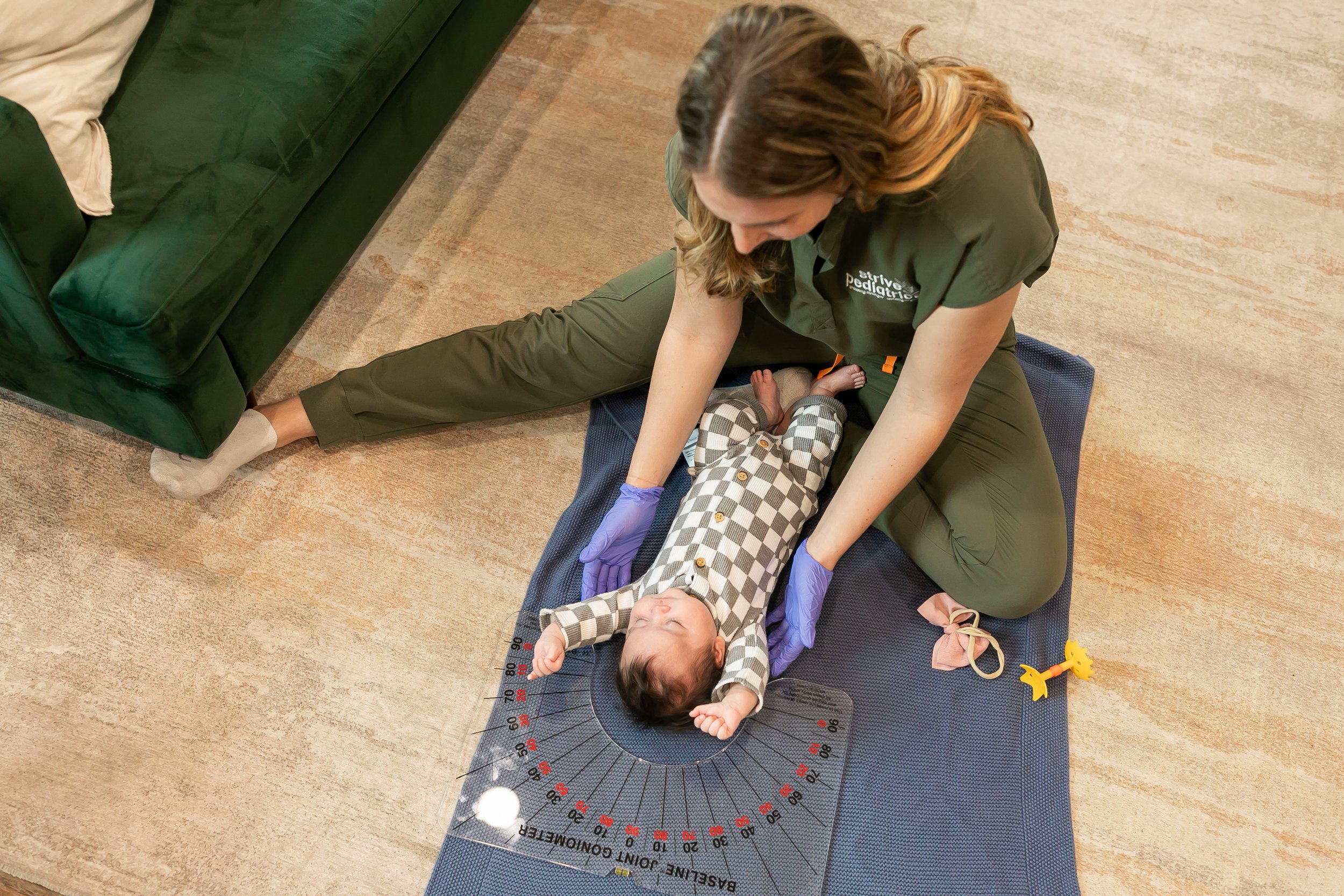Torticollis in Babies: Signs, Treatment, and Why Early Therapy Matters
If you’ve noticed that your baby prefers to turn their head to one side or has trouble looking both ways, they may have torticollis—a common condition affecting neck movement in infants. Without treatment, torticollis can lead to head flattening (plagiocephaly), delayed milestones, and postural imbalances.
The Good News!
Early intervention with pediatric physical therapy can resolve torticollis and prevent long-term complications. The American Physical Therapy Association (APTA) recently updated its clinical guidelines, emphasizing early detection and comprehensive therapy as the most effective treatment.
In this guide, we’ll explain what torticollis is, common signs to watch for, and the best treatment options to help your baby move freely and develop strong, symmetrical movement patterns.
What Is Torticollis in Babies?
Torticollis (also called “wry neck”) occurs when a baby’s sternocleidomastoid muscle (SCM) in the neck becomes tight or shortened, causing the head to tilt to one side while rotating to the opposite side.
Common Causes of Infant Torticollis:
✔ Positioning in the womb (especially with breech presentation or multiple births)
✔ Birth trauma (such as a long labor or use of forceps/vacuum assistance)
✔ Extended time in one position (car seats, swings, or lying on one side)
If left untreated, torticollis can lead to asymmetrical head shape (plagiocephaly), limited mobility, and delays in motor milestones like rolling, sitting, and crawling.
What to Look for:
How to Tell if Your Baby Has Torticollis
Parents often notice the first signs of torticollis before a medical provider does. Look for these common symptoms of torticollis in babies:
• Head tilt or turning preference (baby always looks one way)
• Flat spot on one side of the head (plagiocephaly)
• Trouble turning the head in both directions
• Challenges with tummy time and rolling
• Favoring one side when reaching, rolling, or feeding
• Difficulty latching on one breast due to head position
One simple way to check for torticollis is to look at photos of your baby—if their head is always turned the same way, they may have a movement asymmetry.
Updated “Gold Standard” For Torticollis Teratment
The 2024 APTA clinical practice guidelines emphasize that early therapy leads to better and faster results. Here’s what parents need to know:
1. Start Therapy as Early as Possible
The new guidelines recommend that all babies between birth to 2 days should be screened for torticollis. Starting Physical or Occupational therapy before 2-3 months of age for the best outcomes. The earlier treatment begins, the shorter the time in therapy and the better the outcomes
2. A Comprehensive Approach Works Best
Traditional treatment focused on passive stretching, but research now supports a multi-faceted therapy approach, including:
✅ Manual therapy (gentle stretching and myofascial release)
✅ Addressing the whole body not just the neck
✅ Tummy time and strengthening exercises
✅ Craniosacral fascial therapy to reduce tension
✅ Parent education on positioning and home exercises
3. Whole-Body Therapy is More Effective
Torticollis affects more than just the neck. Babies often develop postural asymmetries, core weakness, and movement delays. It is important to treat the whole body to improve alignment, strength, and motor skills.
Physical Therapy for Torticollis: What to Expect
At Strive Pediatrics, we use a gentle, baby-friendly, whole-body approach to treating torticollis. Your baby’s treatment plan may include:
✔ Gentle stretching and massage to release tight muscles throughout the whole body
✔ Tummy time techniques to build strength
✔ Craniosacral fascial therapy for better full body tissue mobility
✔ An oral functional exam to screen for impairments that may be effecting feeding, breathing and optimal resting mouth position
✔ Repositioning protocol to correct head and face shape
✔ Parent education on play positions and feeding strategies
When to Seek Treatment for Torticollis:
1. Tightness or Stiffness
2. Limited movement to one side or any noted asymmetrical movement
3.Asymmetry in motion
Head Turn Preference
Body Tightness/ C-curve
4. Delayed Milestones
5. Difficulty Attaining Midline
6. Impaired head or face shape
If you suspect your baby has torticollis, don’t wait! According to the latest research, babies treated before 3 months respond faster to therapy with the best results if seen before 1 month, require fewer sessions, and may avoid needing a helmet for head shaping.
At Strive Pediatrics, we specialize in infant physical therapy, torticollis treatment, and milestone support.
Written by: Dr. Katie Kennedy
Need Help?
At Strive Pediatrics, we specialize in infant physical therapy, occupational therapy, torticollis treatment, and milestone support. We offer in-person visits in Austin, TX, and virtual sessions throughout Texas. Our team is ready to provide personalized advice and support to help ensure your baby’s body can move freely, allowing them to feed, play, sleep and breath in the most optimal way.
Contact us today to learn more!
Download our FREE Torticollis Guide for simple stretches and positioning tips to try at home!



